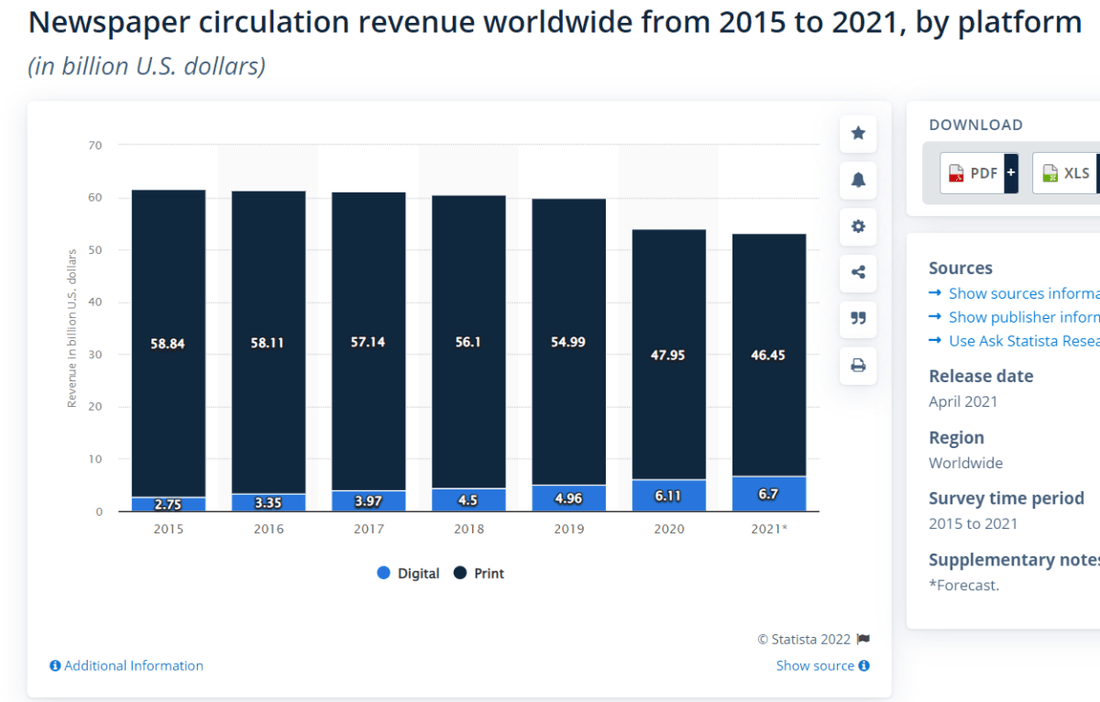
It’s Not Yet Time to Stop Print Advertising
adminShare
In this emerging digital world, print ad revenues have declined over the years, and then came the pandemic. Data shows that the top 25 newspapers in the US have lost 20% of their weekday print circulation between the first quarter of 2020, and Q3 2021. However, it is still impractical for brands to skip this medium altogether. Despite the proliferation of internet connectivity and smartphones worldwide, newspapers remain a credible source of information for billions of readers.
In 2021, newspaper circulation revenue worldwide stood at $46.45 billion, through the print mode, compared to $6.7 billion in digital mode. In the US alone, 70% of households that earn more than $100,000 read newspapers.

Image Source: Statista
In the post-pandemic world, marketers need to be equally nimble as the consumers. The pandemic accelerated the trend of omnichannel presence and hybrid behaviors beyond how consumers shop. Consumers want brands to offer them the best of all worlds, virtual, and in-person. And it’s not just about newspapers only. Print advertising can include magazines, brochures, flyers, and billboards too. Thus, print materials can be used to target a very specific audience in content-specific and industry-related publications.
Picturing the Marketing Funnel is Essential
Members of the International News Media Association (INMA) stress the fact that advertising revenues are bound to lift as economies emerge from the pandemic. In this scenario, brands need to find smarter ways to contextualize print.
In the broader picture, each form of advertising plays a unique role. Print advertising can be considered useful for top-of-the-funnel targeting, which represents the stage where consumers become aware of a brand and its products and services. In contrast, digital ads might be more suited to bottom-of-the-funnel conversions. CTA buttons like “book now” or “buy now” can drive sales.
Neuroscience might support this idea. In a 2015 study, it was established that print media (paper-based content and ads) is better for brand recall, as they can be processed easily by our brains. For instance, the study mentioned that direct mail needed 21% less cognitive effort to process than digital media. In post-exposure memory tests, brand recall was 70% more in participants who were more exposed to a direct mail piece, rather than a digital ad.

Image Source: Forbes
Increased Focus on DEI and Environmental Sustainability Pushing Brands Towards Print
In 2020, print advertising surprisingly gained traction when major brands resorted to long-form print ads on reputed newspapers, to reflect their attempts at rectifying past corporate behaviors. With issues such as racism, and inequality taking center stage in the US political spectrum, brands like Mastercard published full-page print ads in the New York Times, to show their commitment to such causes.
Consumers today, especially Generation Z, will choose to patronize brands that work towards social causes and align with their values. Thus, these companies are choosing a permanent medium like newspapers to showcase their ideas, rather than falling back on a fleeting digital ad. These ads were not urging the readers to buy their products or services, but instead establishing their brand values and advocating a cause. The New York Times has had a history of supporting advocacy ads since the 1920s. The most recent example could be the one where top companies like Unilever, Google, and Morgan Stanley placed an ad to urge then US President Trump to not withdraw from the Paris Climate Accord in 2017.

Image Source: Geospatial World
However, for a small business, accessing the New York Times is a costly affair. They could tap into local newspapers to advertise their values to present and potential customers. For many years, local newspaper revenues have plummeted due to the rise in digital mediums, and ghost newspapers. However, they are an important fabric of the community news and a series of trends in the industry will lead to the resurgence of these publications in the future. The most notable is the Local Journalism Sustainability Act, which has a long way to go, but if it becomes a law, local newspapers and their readers, and advertisers could receive a series of tax credit benefits.
Print ads can help build a brand’s perception as a trusted expert in the industry. This can lead to the growth of the business. The decision of where to place ads is a difficult one, as media audiences are more fragmented than ever. It could be wise to consult a trusted media and advertising consultant to make the right decision.


